 Germany (1901-1918)
Germany (1901-1918)About 630 subs*
WW1 German U-Boats
Brandtaucher | Forelle | U-1 | U-2 | U-3 class | U-5 class | U-9 class | U-13 class | U-17 class | U-19 class | U-23 class | U-43 class | U-57 class | U-63 class | U-87 class | U-93 class | U-139 class | U-142 class | UA | UB-I class | UB-II class | UB-III class | UC-I class | UC-II class | UC-III | Deutschland | UE-I class | UE-II class | U-ProjectsThe invention of submarine warfare: Germany did not invented the submarine but its use in a large scale. That new concept was the submarine warfare, which almost had better result at sea when on land all offensives failed. So strong was this idea that it resurfaced in ww2, with greater force and technology. It made the submarine, just like the aviation, a credible military asset, being taken seriously by naval staff around the world.
For invention, there were many contenders in this field, some quite ancient, and as such, this is a global technological, collective improvement over the years rather than an “invention” out of the blue, just like the steam engine. We can however cite the Brandtaucher (1851) as the earliest known German sub (soon called “unterseeboote”, literally undersea boat).
 Brandtaucher
Brandtaucher
This prototype created by inventor and engineer Wilhelm Bauer was built by Schweffel & Howaldt in Kiel, as a proposal to the Prussian Navy.
Found during a 1887 dredging and salvaged, this pioneering boat is now exhibited at the Bundeswehr Military History Museum, Dresden. Another early attempt was 1870′ Frederich Otto Vogel’s own prototype that sank on trials.
*Great total of constructions launched including those just started and never completed. The real total of completed boat was about 450.
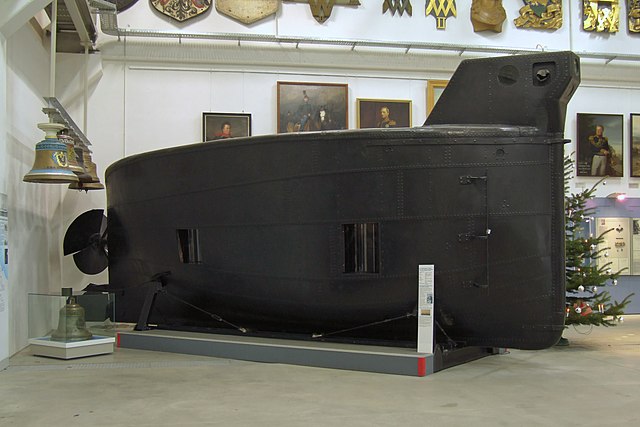
Brandtaucher, 1851, the first German submarine. She sank in Kiel at her first trial.
Story of the Brandtaucher:
The Brandtaucher (“Fire Diver”) was an early German submarine designed in 1850 by the inventor and engineer Wilhelm Bauer which holds the distinction of being one of the first submarines in history. It was originally constructed for the then Prussian navy during the First Schleswig War (1848), as a response to the naval blockade imposed by Denmark. Its method of attack was to sneak in by night and attach explosives to the hulls of some of the blockading vessels. The idea was already explored by Bushnell during the American revolution and by Fulton in the war of 1812. Brandtaucher was Built at the Schweffel & Howaldt shipyard in Kiel, measuring 8.07 meters (26.5 feet) long, made from wrought boiler iron. It was manually powered by a crew of three, turning a crankshaft connected to a propeller. It had ballast tanks that could be filled with water for submerging, emptied to surface. It was tested in 1851 in the harbor of Kiel but had a structural failure caused by water pressure and sank but remarkably, Wilhelm Bauer and his two crew members managed to escape by equalizing the internal pressure with the surrounding water, making it one of the earliest recorded submarine rescues. It was later recovered in 1887, cleaned and restored, now preserved at the Military History Museum of the Bundeswehr in Dresden, Germany as a historical milestone in the evolution of submarine technology and naval engineering.
Early U-Boats
There was a gap before the Nordenfelt design came up in the 1880s. Thorsten Nordenfelt, a Swedish inventor and industrialist founded the world-famous Nordenfelt Guns and Ammunition Company, ltd. in London, and his QF guns by Helge Palmcrantz became a staple of naval warfare throughout the world. His firm later merged with Maxim.
In the meantime, a conversation with reverend George Garrett drove him to design steam submarines somewhat inspired by civil war era confederate CSS Stonewall Jackson and David, or contemporary semi-submerged torpedo-rams like the British Polyphemus, and of course Garrett’s own Resurgam (1879).
The Nordenfelt I was built in Bolinders in Stockholm in 1884-1885 and briefly used by the Greek Navy, while the Ottoman Navy later ordered several boast of the Nordenfelt II type built in Turkey with British parts and the German n°WW1 and n°WW2 built on Nordenfelt blueprints in 1890.
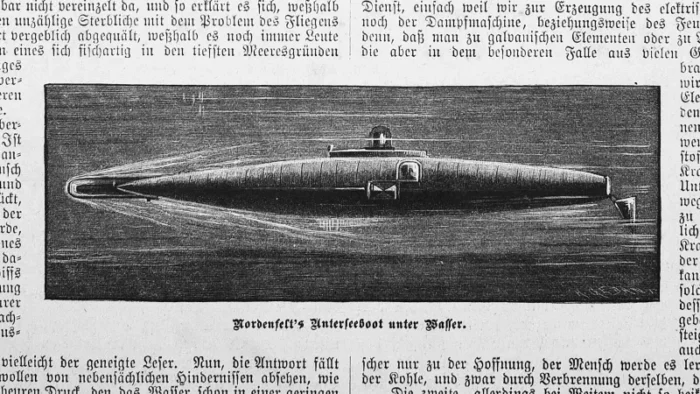
German Nordenfelt design – possibly a rendition of the WW1 or 2. src: unknown
In 1902, Spanish submarine designer R. L. D’Equevilley, was rebuffed by the German Navy while attempting to put up his candidature, especially by Admiral Alfred von Tirpitz that estimated his submarine was too experimental. However D’Equevilley directly sold his plans to the Krupp Germania shipyard.
These plans would serve to design the 40-foot “Forel” on speculation using electricity and batteries a bit like “Gymnote” and the sub was later sold to Russia not before being tested by an impressed Kaiser Wilhelm II and his brother admiral.
The Spanish engineer then published a book on the young history of submarines going as far as stating the appearance of U-Boats may put an end to naval battles.
Krupp next the “Karp”-like improved design was more practical as they fitted a gasoline engine to ride on the surface, and an onboard battery reloading system, of which Russia ordered three and one for the German Navy which became the U-1 (see below).
 Forelle
Forelle
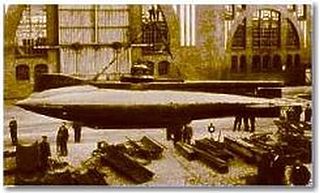 Kiel and its Friedrich Krupp Germaniawerft dockyard Forelle in 1904 was indeed the first German practical submarine. The design was in part funded by the Russians, built on Spanish blueprints. Raimondo Lorenzo D’Equevilley-Montjustin’s design would ater also apply to the U-1. This first single-hull boat had internal ballast and compensating tanks.
Kiel and its Friedrich Krupp Germaniawerft dockyard Forelle in 1904 was indeed the first German practical submarine. The design was in part funded by the Russians, built on Spanish blueprints. Raimondo Lorenzo D’Equevilley-Montjustin’s design would ater also apply to the U-1. This first single-hull boat had internal ballast and compensating tanks.
She was given two Whitehead torpedoes and was quite agile thanks to diving planes and aft planes, but there was a single engine so she has to be released close to her objective. At the time she was completed the Russo-Japanese War ended.
She was conducted from Kiel to Liepāja and commissioned at Kronstadt and then was on rail again, on the Trans-Siberian Railway to Vladivostok where she joined the Pacific fleet. Then by 1908 she was versed to training, and sank later in 1910 by accident. She was salvaged but never repaired.
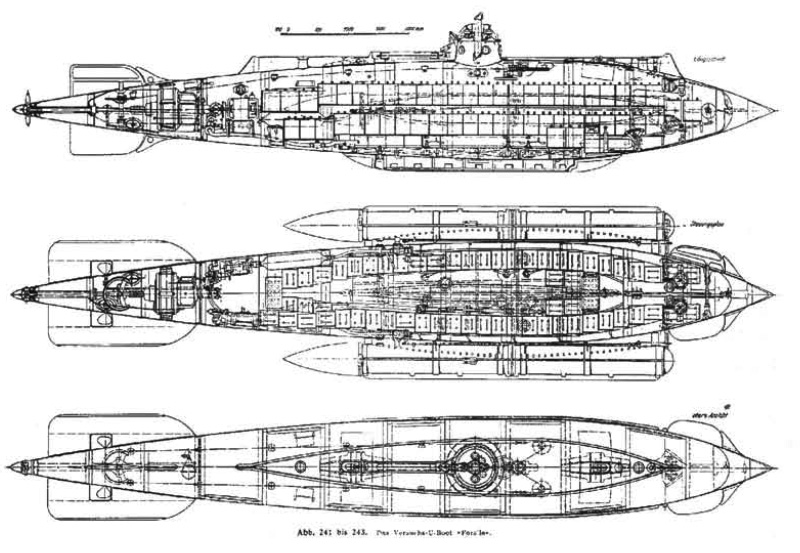
The Forelle (“Trout”) was known for being one of the earliest operational submarines in history, Designed and built by Johann Schaffhausen and Raimund Kirchhoff, marking a significant advancement in naval technology. Constructed in 1903 at Krupp Germaniawerft in Kiel she was the built as a private venture and intended for export as Admiral Hipper at the time did not saw this new technology in a favourable way. Unlike its predecessors, the Forelle demonstrated practical combat capabilities, and was instrumental to design further models such as U1. As a small electric-powered submarine of 13 meters (42.6 feet) in length she was powered by electric motors, with batteries providing energy, for short runs of silent underwater operation. Her design included ballast tanks for submerging and surfacing, as well as basic controls for steering and depth adjustments.
After successful trials she was provided to Russia in 1904 for use in the Russo-Japanese War. The idea was to (again) disrupt the Japanese blockade of Port Arthur so her short range imported little. She was transported by rail to the Pacific and briefly served with the Russian navy before being decommissioned and scrapped. In any case, this prototype demonstrated the feasibility of modern submarines and paved the way for U-1. Its compact size and innovative features made it perfect for small coastal units used in reconnaissance and coastal defense. It also quickstarted the expertise in submarine at Germaniawerft, later became the leading manufacturer of submarines in both world wars.
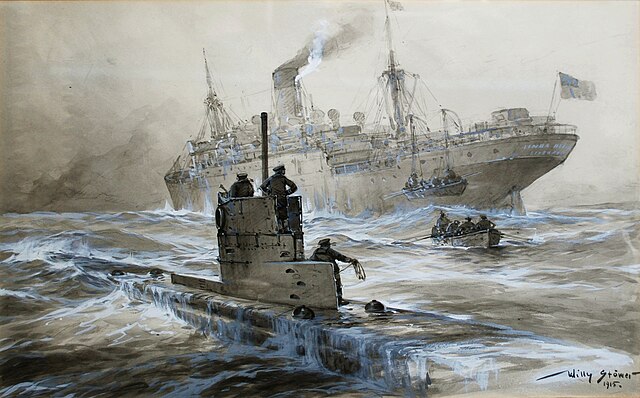
Sinking of the Linda Blanche out of Liverpool (Cityofarts), by Willy Stöwer (1864–1931).
The prewar admiralty program (U1-U31)
Until 1904 von Tirpitz’s opinion of submarines was negative, but after the Forelle’s success he ordered the Torpedoinspektion (‘torpedo inspection’, a department of the Reichsmarineamt, responsible for all development of this new underwater weapon) to design a genuine submarine. The Navy having little experience with this new field of technology, a submarine was ordered from Germaniawerft at the same time for comparative purposes, but important design alterations compared to the boats built for Russia delayed the commissioning of U 1 until 1906.
The Navy-designed boat U 2 was laid down at the Imperial Yard, Kiel and not launched before 1908. In the following year a certain rivalry grew up between Germaniawerft, which had the better knowledge of submarine technology based on the boats they had already successfully built (U 3, U 4 for Austria-Hungary and Kobben for Norway) and the Torpedoinspektion, which had the better design capability.
The controversy died down when d’Equevilley left Germaniawerft, and both parties worked well together thereafter.
The results of this co-operation were U 5-8, the first boats of the Imperial German Navy which were not only trials vessels but had a certain operational value.
In the years 1910–11 the first tactical trials were undertaken, but received a severe setback after the sinking of U 3 in a diving accident on 17 November 1911.
One of the most important problems of this first stage of submarine design was that of propulsion, the first boats having extremely dangerous gasoline and petroleum combustion engines because the development of a reliable lightweight diesel was running into great problems; it was not until U 19 that the first diesel became operational.
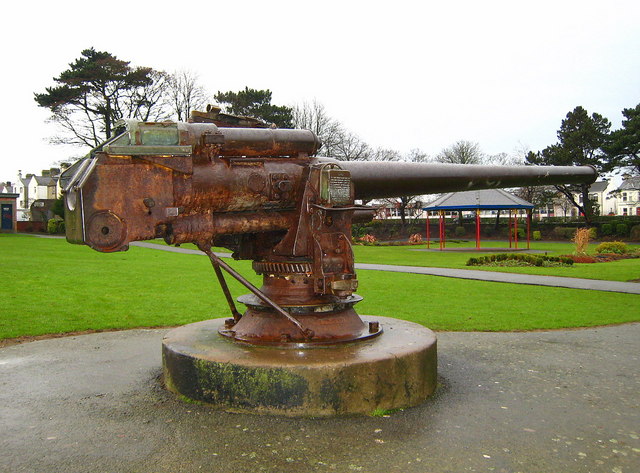
A 88 mm gun at Ward Park Bangor
After the first exercises in 1910—11 the Torpedoinspektion presented its first scheme for U—boat deployment which would be acceptable to the German High Seas Fleet: in 1912.
In its major points it asked for:
lx 36 U-boats in a perimeter patrol securing the Heligoland Bight,
composed of 24 operational boats and 12 boats in reserve.
2x 12 U-boats for the defence of Kiel Bay in the Baltic.
3x 12 U-boats for offensive operations in the North Sea.
4x 10 U-boats as material reserve.
In line with the general emphasis on a surface battleline and the lack of operational experience this was essentially a defensive concept, but nevertheless it requested a total of 70 U-b’oats to be built by 1919, funded by additional special budgets.
Also in 1912 it was decided to purchase a diesel-propelled sub-marine from F iat-Laurenti at La Spezia to gain experiences with foreign diesel technology; delivery was scheduled for 1915 but never took place due to the outbreak of war.
In this first six years of German submarine construction it had shown that the Torpedoinspektion was overstrained by handling all aspects of what had grown into an entirely new service with complex needs, so the Inspektion des U—Bootwesens (Submarine Inspection) was founded as a new independent administrative body.
The pre—war period of German U-boat development shows a steady improvement in technology. Experience was gained rapidly and the benefits were incorporated into each successive types.
Therefore the typology splits up into many different variants depending on the builder and fiscal year whose significant improvements were not apparent in the silhouette but only in internal details. This steady development was abruptly broken when war broke out.
In 1914, the submarine arm of the Imperial German Navy comprised 20 battle—ready U-boats, plus a further 15 in commission or under construction, and the Germans immediately switched to a mobilisation programme, the first so called types being U 51 and U 56.
However it was soon evident that completion times of such sophisticated weapons would be too great, considering the expected short duration of this war. Immediately after the outbreak of hostilities the U-Bootsinspektion was asked in August 1914 for preliminary studies for a small, single-shaft U-boat capable of railway transportation in sections.
Although this concept was rejected at first, the occupation of the Belgian coast quickly led to further pressure to develop both a torpedo and minelaying type.
In September 1914 the later UB type was chosen out of a variety of designs, and one week later the first 15 units were ordered, the prototype boat UB I being built within a hundred days. One month later the design for the minelaying UC type had reached a stage where 15 units could be ordered.
Development
U-1 was an improved Kiel design based on the Forelle, still based on plans by Spanish engineer D’Equevilley but tis time combining gasoline engine and a battery reload system.
Combining good surface speed to underwater depht and range, she became not only the first U-boat but also the most successful submarine worldwide. This single unit was followed by to Csarist Russia as part of a submarine export deal also comprising three Karp class boats.

Compared outlines of German WW1 U-boats
The controversy died down when d’Equevilley left Germaniawerft, and both parties worked well together thereafter. The results of this co-operation were U 5—8 , the first boats of the Imperial German Navy which were not only trials vessels but had a certain operational value.
In the years 1910—11 the first tactical trials were undertaken, but received a severe setback after the sinking of U 3 in a diving accident on 17 November 1911.
One of the most important problems of this first stage of submarine design was that of propulsion, the first boats having extremely dangerous gasoline and petroleum combustion engines because the development of a reliable lightweight diesel was turning into greater problems. It was not until U-19 that diesel U Boat truly became Operational, the first diesel of the kind.
The numbers of the first two series were deliberately and could gain experience under battle conditions and incorporate the lessons into the next series.
To explain German submarine typology it is necessary to note that UA was a submarine under construction for the Norwegians and that the UD types were those under construction for the Austro-Hungarian Navy, all of which were taken over by the Imperial German Navy after their completion.
Because of the delicate status of Commerce warfare in international law great emphasis was laid on submarine minelayers, and as early as January January 1915 the design for the ved UE type was ready. Unlike its rather primitive forerunner, the UC type, it carried its 34 mines in dry stowage and had two TT in the deck structure for active hunting.
A further variant (UF) would have had an all-torpedo armament and thus represented the logical approach to a small, quickly built mass-production coastal submarine, but was rejected in favour of ocean-going Ms type U-boats.
Therefore the design and ordering policy for German U-boats also mirrors the frequent changes in administrative direction outlined in the introduction. The German ‘war-zone declaration had been promulgated on 1 February 1915, and consequently some two dozen Oceanic Ms type submarines were ordered.
But the major bottleneck was the delivery of the diesel engines, so design switched back to the coastal types of which the improved UB II and UC II types emerged in the spring of 1915. The enlarged Ms type Project 43’ (U 115, U 116), with a 20 per cent increase in radius of action was not put forward until the autumn of 1915.
The unrestricted U-boat war envisaged in the spring of 1916 nevertheless revealed a shortage simple, mass-produced boats for torpedo-based commerce Wartalo around the British Isles. The resulting design was a compromise bet ween the ocean-going Ms types and a scaled-up coastal UB design:
The UB III type in which the added offensive component (4 more spare torpedoes) was paid for with decreased speed and endurance compared with the basic U 19 type.
Because of increasing material and manpower shortages the first orders were not placed until May 1916, the boats not being delivered before the summer of 1917.
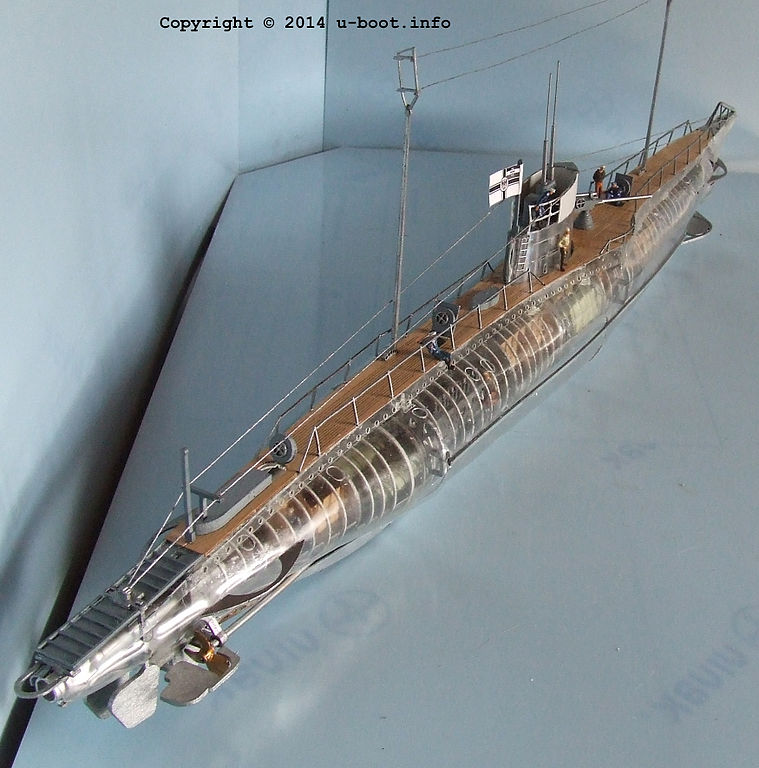
Model kit cutout of an UB-III
After the abandonment of the first attempt at unrestricted U-boat warfare in March 1916 for political reasons, the Admiralty ordered designs for large submarine-cruisers with bin guns capable of commerce warfare according to Prize Laws.
Operational and handling experience with such large vessels had already been gained with the clumsy merchant submarines of the Deutschland class.
The only bottleneck was still the high-power diesels needed to obtain the requested high surface speeds. Nevertheless U-cruisers of the types 46 and 46a were designed, and in August 1916 the first such boats (U 139-U 141) were ordered by postponing the Ms types U 111-U 114 and U 127 U 130.
The former merchant submarines were also converted into U-cruisers and commissioned as U 151-U 157, since their intended role was nullified when the USA entered the war, so in the final analysis of the U-cruisers were merely a design answer to the requirements of a type of warfare that had become obsolescent by the declaration of the unrestricted U-boat war.
What Germany needed now were UB III types – for the same reasons as one year previously – and indeed they were ordered in great numbers up to February 1917 (UB 88-UB 132).
After the highest priority had finally been given to U-boat production in June 1917, a further 95 were ordered:
37 UB III types UB 133–169, 39 UC III types (improved minelayer) UC 80-UC 118, 10 U-cruisers U 173–U 182 and 9 Ms types U 164–U 172, which were scheduled for completion between the summer of 1918 and January 1919. Because of earlier efforts the number of operational German U-boats in the First World war.
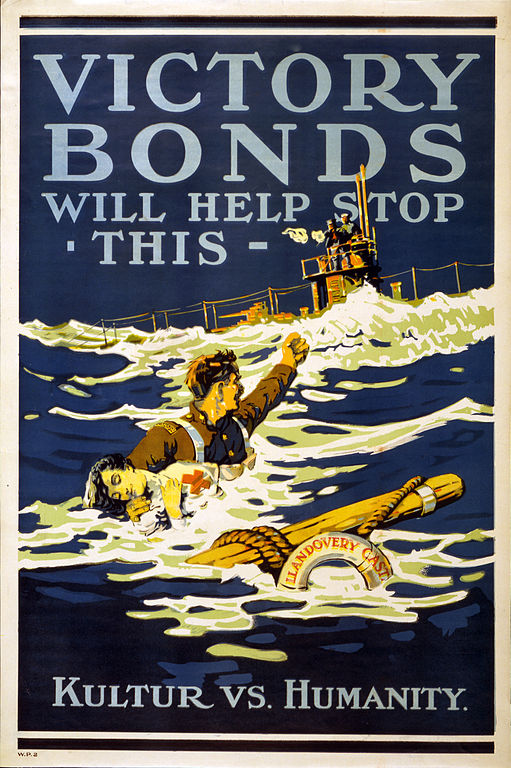
Submarine fear: War bond propaganda poster – Llandovery Castle.
War was at its peak in October 1917 with 140 units, but by then it was too late, as von Tirpitz had foreseen: the Allies had introduced the convoy system in May and had developed new ASW techniques and weapons in the previous years.
After some changes in priorities the programme of June was revised in December 1917 and increased to 120 units, which meant that 11 shipyards had to work around the clock and that all other construction had to be curtailed.
Nevertheless increasing material shortages and manpower problems caused by food shortages and a nationwide influenza epidemic in the spring of 1918 proved that the schedules could not be kept in any fashion.
The German spring offensive in France finally collapsed in August 1918 and when Admiral Scheer became the new Commander in chief in the same month, he was backed by von Hindenburg and Ludendorff in his insistence that all efforts must be concentrated on U-boat construction and warfare to regain the offensive at sea, since the war could not be won in continental land battles: the necessary material and manpower would be taken from the Army’s allocations.
This resulted in the ambitious ‘Scheer programme’ which asked for an increase in the number of completed U-boats by a further third.
While exhausting conferences took place on how to ensure the necessary steel production, diesel production, shipyard capacity and manpower, the general situation worsened after the collapse of Bulgaria in September.
Without any chance of realisation the preparatory steps of the ‘Scheer programme’ were pushed forwards because Scheer regarded a strong submarine force as an important bargaining counter in coming peace negotiations.
In the meantime German politics had drastically changed with the new Imperial Chancellor Max von Baden, who initiated steps for an armistice.
Up to the last moment German naval authorities obviously grossly underestimated the Allied determination to wipe out the German submarine force completely.
During the war the following German submarines were sold to Austria-Hungary: UB 1 became Unterseeboot 10, UB 15 became Unterseeboot II, UB 43 became Unterseeboot 43 and UB 47 became Unterseeboot 47;
The renumbering of German U-Boats operating in the Mediterranean and the Adriatic is covered in the Austro-Hungarian section.
UB 8 was sold to Bulgaria. Unlike World War Two no intact German U-boat was captured but two sunken coastal submarines were raised and put into commission:
Italy raised UC 12 and renamed her X 1; France raised UB 26, which was renamed Lieutenant Morillot. From 1906 to 1918 the Imperial German Navy ordered a total of 811 U-boats, out of which 343 were commissioned.
134 of them were lost in action, 42 by mines, 17 were lost by accident (some of them raised and recommissioned), 14 were scuttled by their crews, mostly in the Black Sea or in Austrian ports at the end of war, 8 were interned in Sweden and Portugal, but had to be delivered after the armistice, the total of surrendered U-boats making 175, 19 of which were lost by accident during the transfer tow to British ports.
Of the nearly completed boats 9 were scrapped in Germany after the war, as were 69 lying unfinished on the slips. Note that these figures cannot be added up to a single total since many of the boats appear in two or three of the above-mentioned fates.
The surrendered U-boats were redistributed amongst the Allies, Britain scrapping its share, the USA getting U 111, U 117, U 140, UB 88, UB 148 and UC 97, which were finally sunk as trials targets. The Netherlands were allowed to retain the raised UC 8 which was commissioned as M 1. Japan received U 46 (renamed O 2), U 55 (O 3), U 125 (O 1), UB 125 (O 6), UB 143 (O 7), UC 90 (O 4) and UC 99 (O 5), which were soon scrapped. Italy got U 54, U 114, U 163, U 120, UB 80, UB 95, UB 102, UC 93, UC 94 and UC 98 all of which were immediately scrapped. France’s share reads as follows, the names of the recommissioned boats being given in brackets (all others were scrapped): U 25, U 38, U 39, U 57, U 71, U 79 (Victor Réveille), U 91, U 105 (Jean Autric), U 108 (Léon Mignot), U TD, U 157, U 160, U 162 (Pierre Marast), U 166 (Jean Roulier), U 110) U 119 (René Audry), U 121, U 136, U 151, UA, UB 6, UB 8, UB – UB 24, UB 73, UB 84, UB 87, UB 94 (Trinité Schillemans), UD (Carrissan), UB 114, UB 121, UB 154, UB 155 (Jean Corre), U UC 23, UC 27, UC 28, UC 56, UGC 58, UC 74, UC 100, UC UC 104, UC 107 and U 139 (Halbronn).
 U1 (1906)
U1 (1906)
This was the very first U-Boote (“unterseeboote – submarine boat”) of Germany – A country which was going to manufacture and design more of these than any other Nation in history.
In 1900, William II had no other ambition than to endow his empire with a Hochseeflotte capable of fighting in equal terms with the Royal Navy of his cousin Edward VII of England. Submarines received therefore low priority.
If two other submersibles were tested in 1891 and 1897, the first modern U-Boote was defined at Howaldswerke yards by Spanish engineer d’Ecquevilley, a former teamworker of Gustave Laubeuf, and his right-hand man.

She beared some similarities with the “Narval”, being in essence also a “submersible torpedoboat”, good walker on the surface. Despite the reluctance of Tirpitz, the dedicated department of the Reichsmarineamt was authorized to resume research works started with the Forelle, carried out with the three “Karp” sold to Russia.
The U1 was equipped with Körting kerosene engines, efficient and reliable.
She did, however, had a removable evacuation tube that caused quite long flipping maneuvers before any dive.
Nevertheless, this ship which carried out tests until the end of her short working life (1919) was a brilliant precursor.
She was removed from the lists but the builder purchased her back, well aware of the historical significance of these symbolic units in 1919, and donated her to the Munich Museum where she can be seen today.
| Specifications | ||
| Displacement & Dimensions: | 238t/283t (surface/underwater) 42,4 x 3,8 x 3.2 m | |
| Propulsion: | 2 shafts, 2 kerosene engines, 2 electric engines, 400/400 hp. 10,8/8,7 knots s/dive | |
| Crew: | 12 | |
| Armament: | 3 x450 mm TTs bow | |
 U2 (1906)
U2 (1906)
SM U-2 was a German U-boat built for the Imperial German Navy, a prototype sometimes called the “Type U 2” was built, ordered from Kaiserliche Werft of Danzig on 4 March 1906 and launched on 18 June 1908, commissioned into the Imperial German Navy on 18 July 1908 at a Cost of 1,548,000 Goldmark.
On 18 July 1908 she was commissioned under command of Lt. Cdr. Karl Bartenbach and went straight to the training flotilla. She was used for training, having no war patrols to her credit, mostly static in WWI. She was used as such until the surrender. She was decommissioned on 19 February 1919 and sold for BU on 3 February 1920.
The official design was based on what naval chief architect Gustav Berling prepared in 1905 for the U 1. This was a so-called “double-hull boat” designed for coastal patrol, just as U1 was still being built. Her Körting parrafin engines were rated for 441 kW (600 hp). But they were adopted by default as new diesel engines from Daimler could not be provided. They were retrofitted in 1910 still. The two Siemens SSW electric motors installed had a good output but operation of the dynamo proved difficult. Also on trials, both her agility and general seaworthiness left a lot to be desired.
Technically speaking, this was a much refined Kiel design, longer, larger but with the same draught and significantly heavier than U1, better powered for a knot more on average surfaced and underwater, thanks to two Daimler 6-cylinder four stroke paraffin motors rated for 600 PS (440 kW; 590 shp) at 550 rpm surfaced and when submerged, two SSW electric motors rated for 630 PS (460 kW; 620 shp) total, at 685 rpm. The shafts were large at 1 m (3 ft 3 in). Top speed was thus better at 13.2 kn (24.4 km/h; 15.2 mph) surfaced and 9 knots (17 km/h; 10 mph) submerged.
But overall, she had a greater range at 1,600 nautical miles (3,000 km; 1,800 mi) at 13 knots (24 km/h; 15 mph) surfaced compared to 1,500 nmi (2,800 km; 1,700 mi) at 10 knots for U1 but the same underwater at 50 nautical miles (93 km; 58 mi) at 5 knots (9.3 km/h; 5.8 mph). She was capable of a test depth of 30 m (98 ft), and under her outer deck she carried a dingy for ship to shore travel.
Her complement was of 3 officers, 19 men and for the first time she had a fill battery of two internal (pressure hull) torpedo tubes, a pair each at the bow and stern for four inside the tubes and two reloads, six total 45 cm (18 in) torpedoes. Again, this compared well to U1’s single tube with 3 C/03 torpedoes in reserve. See a profile and photo on uboot-recherche.de. No CC photo.
| Specifications | ||
| Displacement & Dimensions: | 341 t surfaced, 430 t submerged, 45,42 x 5,5 x 3.05 m | |
| Propulsion: | 2 shafts Daimler 6-cyl 2 stroke Parrafin engines, 2 electric engines, 600/630 hp. 13.2/9 knots s/uw | |
| Crew: | 3+19 | |
| Armament: | 4 x450 mm TTs bow, stern (6 torpedoes) | |
 U3 (1908)
U3 (1908)
The U2 was produced two years after the U1, and unlike the first, she was launched at the imperial shipyard of Kiel.
In the course of Howaldswerke, the shipyard was inspired both by her forerunner and the French Narval (Ecquevilley then drove the engineering office of the submersible branch). She also incorporated the lessons learned by the construction of U3 and Austro-Hungarian U4, and the Norwegian Kobben.
Launched in June, operational at the end of 1908, the U2 passed test batteries before retiring in 1919.
She was also the first German training submarine. Although larger, her autonomy (46 tons of oil against 20) and surface speed were much higher, as her carrying capacity rose to 6 torpedoes vs 3 on the U1.
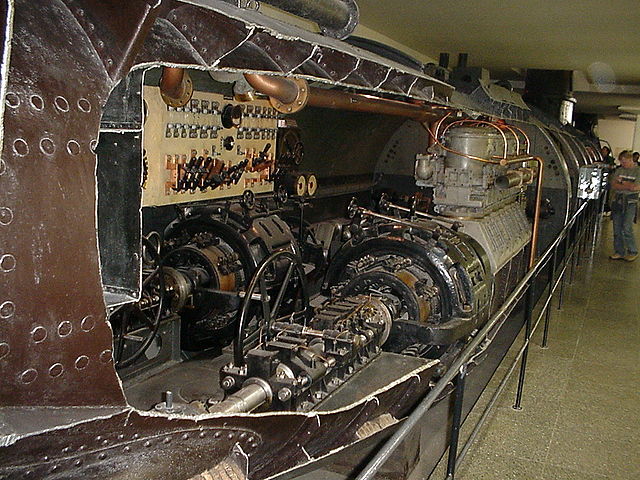
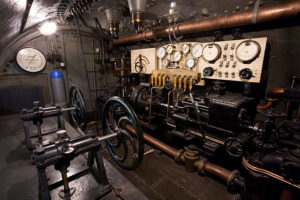
Cutouts of the U-1 in Munich Deutsche Museum
| Specifications | |
| Displacement & Dimensions: 341/430 tonnnes surface/uw – 45,4 x 5,5 x 3,1 m | |
| Propulsion: 2 shafts, 2 kerosene Daimler engines, 2 electric engines, 630/600 hp. 13,2/9 knots s/dive. | |
| Armament: 4 x450 mm TTs 2 bow, 2 stern | |
| Crew: 22 | |
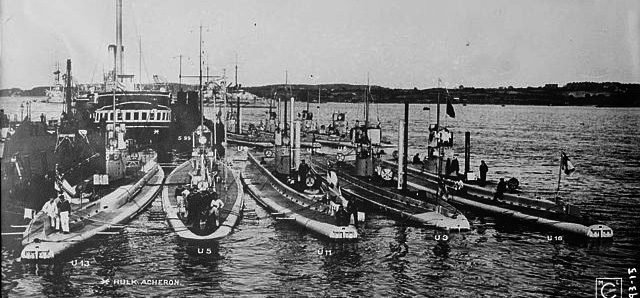
U-3 and other submarines at Kiel in 1914
U3 and U4 represented the first “serie” of German submersibles. They were built in Danzig, launched in 1909 and operational in early 1910.
Significantly larger than the U2, the U3 and her twin had characteristics that would be duplicated on the following series. Their surface speed was slightly retreating, but their diving speed increased.
Moreover their crew was left unchanged thus the hull felt less cramped. The U3 suffered a diving accident which cost her the entire crew.
She was later refloated but was never operational again in 1914, being used instead to test new systems and as a training vessel.
The U4 also spent her career as training sub, but conducted some patrols in the Baltic sea, in 1914-18. She will be broken up in 1919.

U-3 and other submarines at Kiel, 1914
| Specifications | |
| Displacement & Dimensions: 421/510 tonnes surface/dive – 51,3 x 5,6 x 3,1 m | |
| Propulsion: 2 shafts, 2 kerosene Daimler engines, 2 electric engines, 600/1030 hp- 11,8/9,5 knots s/dive. | |
| Crew: 22 | |
| Armament: 4 x450 mm TTs 2 bow, 2 stern, 6 torpedoes | |
 U5 (1910-11)
U5 (1910-11)
The U5 was the first of a series of four units, with U6, 7, and 8. They were built at Germaniawerft, Kiel, on plans directly inspired by the U3. They were even bigger, this time reaching 500 tons, and their propulsive power was doubled (4 engines instead of 2).
As a result, they surface speed was 13.5 knots while their diving speed was increased further. They also had a better range, carrying 54 tons of fuel oil, for a 1900 nautical mile (3500 km) radius of action.
They were also operational and fought during the first two years of the war, in 1914 and 1915, but were destroyed: The U5 hit a mine, the U6 was torpedoed by HMS E16, the U7 was accidentally torpedoed by U22, and the U8 was sunk by two destroyers (Maori and Gurkha, of the “Tribal” class).
| Specifications | |
| Displacement & Dimensions: 505/636 tonnes surface/dive – 57,3 x 5,6 x 3,6 m. | |
| Propulsion: 2 shafts, 4 kerosene Körting engines, 2 electric engines, 900/1040 hp – 13,4/10,2 knots s/dive. | |
| Armament: 4 x450 mm TTs 2 bow, 2 stern, 6 torpedoes | |
| Crew: 29 | |
 U9 (1910)
U9 (1910)
The U9 was the first in a series of four submersibles built at Danzig and closely derived from the U5. Their length was unchanged, but their width was increased by 40 cm while their draft was 50 cm lower. Their surface speed was increased from 13.4 to 14.2 knots, while their underwater speed was 8 knots.
Their engine power was greater, but their fuel oil supply was reduced by two tons and their autonomy, with a superior displacement regained 100 nautical miles on the surface.
These four units were heavily committed in action, only U9 surviving the war. The U10 hit on a mine in May 1916, U11 on December 9, 1914, and U12 was rammed by HMS Ariel on March 10, 1915.
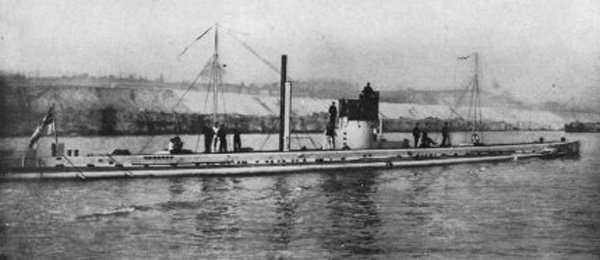
U-9 at sea, date unknown
| Specifications | |
| Displacement & Dimensions: 493/611 tonnes surface/dive – 57,4 x 6 x 3,1 m. | |
| Propulsion: 2 shafts, 4 kerosene Körting engines, 2 electric engines, 1050/1160 hp – 14,2/8,1 knots s/dive. | |
| Armament: 4 x450 mm TTs 2 bow, 2 stern, 6 torpedoes | |
| Crew: 29 | |
 U13 (1911)
U13 (1911)
The U13 was the class leader of three units built in Danzig and closely derived from the U9, but also the U16 built by Germaniawerft and almost similar (significantly lower displacement, one more knot in surface).
A little larger than the U5-U9, they fried the 58 meters and the draft was now 3.40 meters.
The power of Kerosene Körting machines was the same as that developed by the batteries: 1200 hp. As a result, the surface speed climbed to 14.8 knots while diving speed was 10.7 knots, the best so far.
The hulls of these units did not differ much from the others, having the same sections and an almost intangible kiosk, the same armament and the same crew from the U2. They paid a heavy price early in the war, the U13 being sunk by gunfire on August 9, 1914, the U14 rammed by trawler HMS Hawk in June 1915 and U15 by the cruiser HMS Birmingham the same day.
The U16, for her part survived only to be captured and then towed to Great Britain in 1919, but sank during her transfer.
| Specifications | |
| Displacement & Dimensions: 489/627 tonnes surface/dive – 57,8 x 6 x 3,4 m. | |
| Propulsion: 2 shafts, 4 kerosene Körting engines, 2 electric engines, 1200/1200 cv – 14,8/10,7 knots s/dive. | |
| Armament: 4 x450 mm TTs 2 bow, 2 stern, 6 torpedoes | |
| Crew: 29 | |
 U17 (1912)
U17 (1912)
U17 and U18 were built in Danzig on new blueprints. The goal was mainly to create units with a higher autonomy, and they reached indeed 6700 nautical in surface at 8 knots (cruising speed) against 2100 at 15 knots on older units. Their submerged speed was in regression, but their surface speed jumped only slightly.
The more powerful Körting engines were also later used. Diesels were being developed for the new generation of U-bootes, a winning formula as we know. For the rest, the armament did not change.
The U17 was assigned as an instructional submarine from 1916 and the U18 was sighted and sunk by Scapa Flow’s coastal batteries, attempting to approach on the surface by night the famous Naval Base. The feat would be realized in 1939 by Günter Prien with the U47.
| Specifications | |
| Displacement & Dimensions: 564/837 tonnes surface/dive – 62,4 x 6 x 3,4 m. | |
| Propulsion: 2 shafts, 4 kerosene Körting engines, 2 electric engines, 1400/1120 hp – 14,9/9,5 knots s/dive | |
| Armament: 4 x450 mm TTs 2 bow, 2 stern, 6 torpedoes | |
| Crew: 29 | |
 U19 (1912)
U19 (1912)
The U19 class (4 units) was the first class in the world of Diesel-powered submersibles. The revolutionary formula invented by German engineer born in Paris Rudolf Diesel in 1897 at the MAN factory changed the game.
The engine also operated with vegetable oils at the origin, the first “multifuel”… The Danzig shipyards that launched this first series, were followed quickly by Germaniawerft ones.
MAN thus succeeded Körting, with one of the longest commission and licensed production in industrial history. These engines allowed a much faster dive and were more powerful and significantly more economical, reaching an autonomy of 7600 nautical.
But this class also introduced for the first time 500 mm tubes, more likely to sink better protected military ships, and a 88 mm deck gun, which could constitute a significant complement when U-Bootes were supposed to have spent their 6 torpedoes, or to defend themselves instead of being systematically forced to dive. These four units all survived the war.
| Specifications | |
| Displacement & Dimensions: 650/837 tonnes surface/dive – 64,2 x 6,1 x 3,6 m. | |
| Propulsion: 2 shafts, 4 kerosene Körting engines, 2 electric engines, 1700/1200 hp – 15,4/9,5 knots s/dive. | |
| Armament: 4 x500 mm TTs 2 bow, 2 stern, 6 torpedoes, 1x 88mm gun | |
| Crew: 29 | |
 U23/U27/U31 “Mittel-U” (1913-14)
U23/U27/U31 “Mittel-U” (1913-14)
The U23 class (4 units) or “mittel-U”, was the second class equipped with Diesels, a copy of the U19 by Germaniawerft, from the large imperial shipyard of Kiel, recovering the MAN license and conceiving its own diesels, six cylinders two-stroke.
The latter gave 100 hp more than the U19 MANs, the surface speed being increased to 16.7 knots. The diving speed was also higher as well as the autonomy.
They were also heavier, equipped with a double-hull and able to dive to 50 meters with a dive time of 2 minutes and 13 seconds.
They had only one 88 mm gun, but in 1915, a second was added, even a 105 mm on some units. The U27 class (4 units in 1913) built in Danzig had an improved diving time of 80 seconds.
Finally the U31 class, developed in 1914, was designed by Germaniawerft as a war series of 11 boats, the last being launched in November 1914. They were a little heavier but similar to the U27.
The U35 was by far the one with the best hunting board of any war: 225 ships! She was led by Prussian Ace De la Périere. 12 of these submersibles were lost during the war in all. The characteristics below are those of U31:
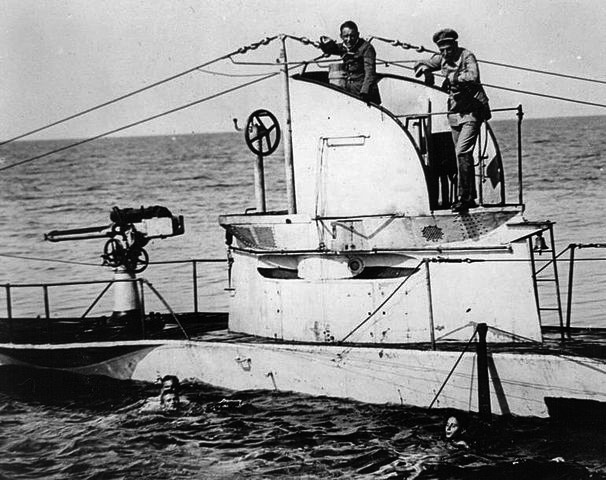
U-27 Kiosk
| Specifications | |
| Displacement & Dimensions: 685/878 tonnes surface/dive – 64,7 x 6,3 x 3,5 m. | |
| Propulsion: 2 shafts, 4 kerosene Körting engines, 2 electric engines, 1850/1200 hp – 16,4/9,7 knots s/dive. | |
| Armament: 4 x500 mm TTs 2 bow, 2 stern, 6 torpedoes, 1x 88mm gun, 1x 7.7mm MG | |
| Crew: 29 | |
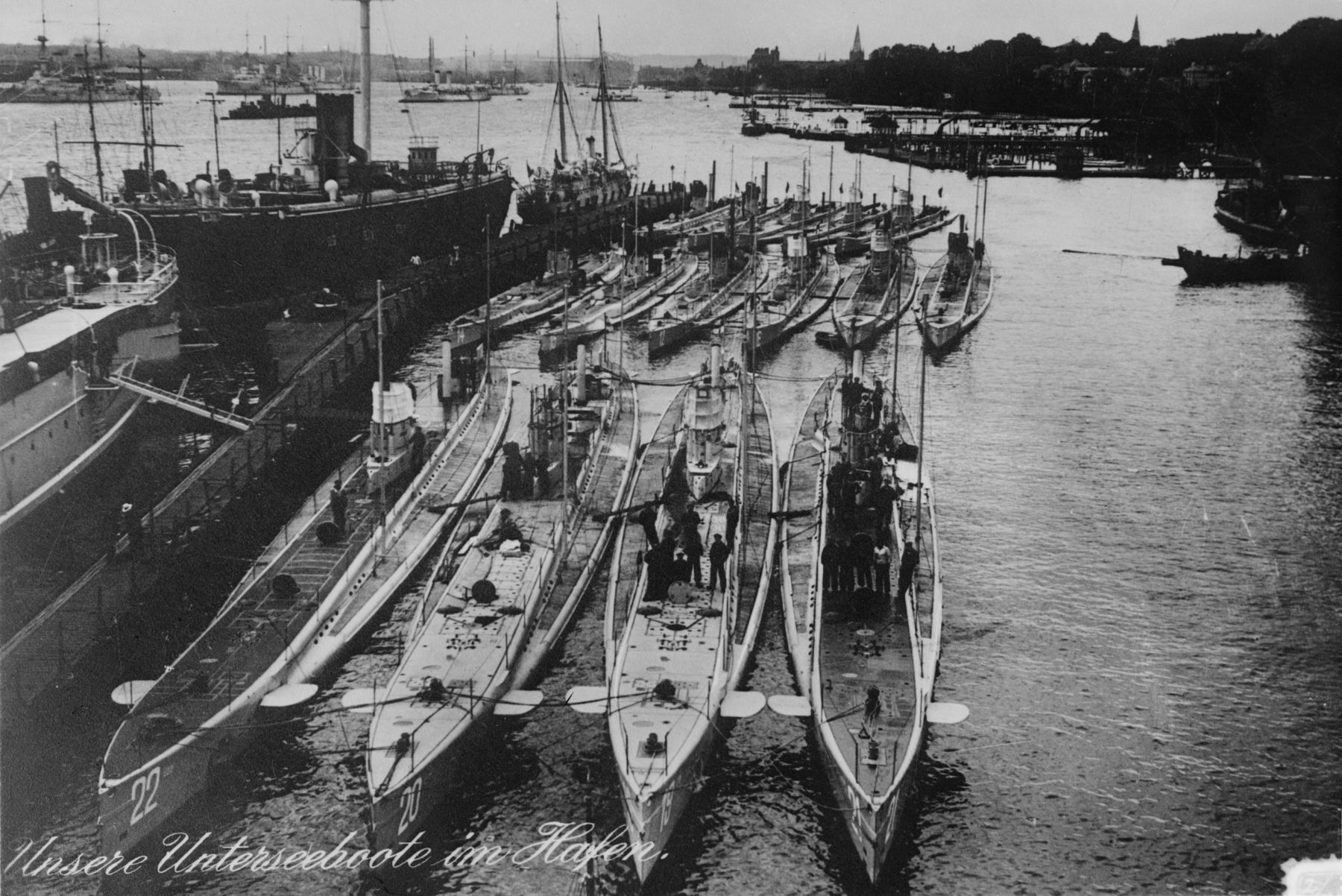
U-boats at Kiel in 1914
German U-Boats in the Great war
Wartime saw a rapid increase in production and capabilities as tremendous successes were soon registered, the like of which will never repeat in WW2.
Successes came quickly, and various U-boat commanders soon registered impressive hunting boards of dozens of ships. This was before 1917, when the surface fleet was all but retired from operations, and submarine total war was approved by the Kaiser.
Unfortunately this move backfired as the Lusitania, carrying American citizens was sunk, angered the opinion and bring the Wilson further from the war, while not a decisive factor. The late consequence was to unleash the full might of American industrial capabilities, with the delivery of hundred of destroyers at the end of 1918.
Coupled with British comparable efforts since 1915, new dispositions, tactics like protected convoys and Q-ships, the balance started to reverse in favor of the allies.
But German submarine development grow both in quantities and quality as budget and motivation was redirected to this effort.
Some of these late submarines were so advanced they were copied after comprehensive study through war reparations by all navies.
Such was the aura of German U-Boat expertise that despite Versaille treaty interdiction, the Hague Bureau in the 1930s was producing effectively export submarines derived from these 1918 designs. Another aspects was the diversity of models.
Germany launched at first decent mid-range types, not truly oceanic either coastal. But after years of development, they reached three standards:
-The Oceanic type: U71, 81, 87, 93 classes.
-The cruiser types: Very long range (capable to crosse the Atlantic or reach the Pacific): Deutschland, U139, U142, U151.
-The coastal classes (UB): UA, UB 1, 18, 48
-The coastal minelayer classes UC1, 16, 80.
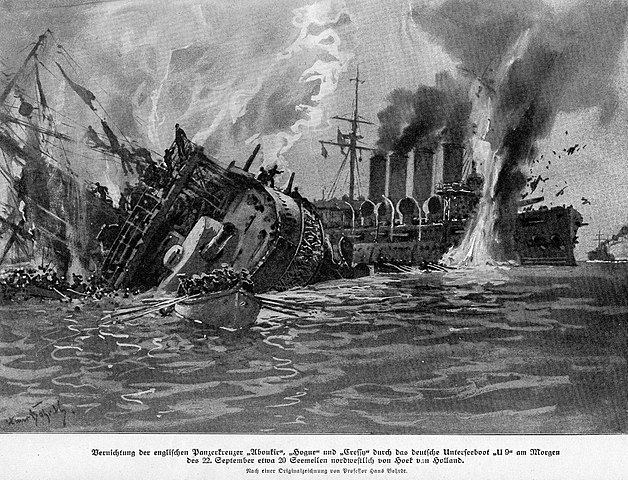
Three armoured cruisers torpedoed and eliminated the same day, U-9′ Otto Weddingen feat was never repeated but showed to stunned admiralties what this new weapon can do
The time of U-boat German Aces
This era saw U-9 of commander Kapitänleutnant Otto Weddigen sinking in one swoop three British armored cruisers, the Cressy, Hogue and Aboukir, the action of 22 September 1914.
The two cruisers stopped to assist rescuing the crews in turn. Submarine capabilities were known but not entered mentalities yet, still dominated by surface warfare on sight. This was the era of the first aces, and submarine aces were perhaps less glamour and popular than their airborne counterparts but not less successful.
Let’s cite only because the chapter would cover an entire post of its own, the most prominent U-Boat aces has been overall a Prussian of French noble descent since 1757, Lothar von Arnauld de la Perière. Not only he was the most succesful U-boat commander of the Great War, but of history as well.
He claimed 194 ships for 453,716 tons. He was punctilious about respecting rules of engagement for civilian ships, ensuring they had evacuated all personnel and passengers and knew the safe route to a port before destroying the ship.
He often preferred dynamite placed by a boarding party of his gun to sink the ship rather than using his torpedoes.

U-38 at sea, a prewar submarine
There were many other submarine aces, no less impressive: Walther Forstmann (147), Max Valentiner (150), Otto Steinbrinck, Hans Rose (90), Walther Schwieger (49), Reinhold Saltzwedel (111) and many other with 50+ “kills”. In comparison, the best WW2 submarine ace was Otto Kretschmer (47 ships).
It should be noted however that if numerous kills were obtained in the early part of the war, the bulk were obtained following the “unrestricted submarine warfare” in six month, 3/4 million tonnes were sunk, which barely made a dent in the considerable British merchant marine.
The allied however were not that successful with early countermeasures, and from 1917 adopted the Dazzle camouflage (with again mixed results), and the “Type D” deep charge became available in January 1916. By the end of the year only two U-boats has been reported sunk by these. https://en.wikipedia.org/wiki/U-boat_Campaign_(World_War_I)
 U43 (1914-15)
U43 (1914-15)
The 8 units of the U43 class (the U42 was commissioned to the Italians, especially to have an overview of the FIAT diesels, and requisitioned and integrated into the Italian Navy in August 1914 under the name of Balilla). They were designed and built by Danzig at the beginning of the war.
They were marked by a hull and a kiosk completely revised in light of the very first operations. These ships were marked by a higher draft, and a displacement approaching 1000 tons underwater. They had a dive time of 1 minute and 45 seconds, and were armed “as standard” with two 88 mm KL/30 (Kaliber 30) guns, but during the conflict, a single 88 mm or 105 mm gun was sometimes adopted. From 1916, U43 and U44 were rebuilt and re-equipped as minelayers. There were 5 losses in action and one scuttled in Nov.1918. The U46 was awarded to Japan as war reparation, becoming O2, but was broken up in 1922.

U-45
| Specifications | |
| Displacement & Dimensions: 725/940 tonnes surface/dive – 65 x 6,2 x 3,7 m. | |
| Propulsion: 2 shafts, 4 kerosene Körting engines, 2 electric engines, 2000/1200 hp – 15,2/9,7 knots s/dive. | |
| Armament: 4 x500 mm TTs 2 bow, 2 stern, 6 torpedoes, 1x 88mm gun, 1x 7.7mm MG | |
| Crew: 36 | |
 U57 (1916-17)
U57 (1916-17)
The 12 boats of the U57 class (U57-U62 and U99-U104) were built for the first time by a third yard hitherto little interested in this type of units.
But the need for large oceanic submersibles required new contractors to the Admiralty. They came from AG Weser in Bremen, the U99 being a variant of the U27.
Their performances were in withdrawal. The U57s had modified hull flanks, a remodelled kiosk, and like the U51, two 88 mm guns and 7 torpedoes for 4 tubes (first group), and 10-12 for the second group.
Some units were armed with a 105 mm piece, and three units (U58 to U60) received a 105 mm KL/45 used for AA defence at the same time as a 88 KL/30. There were 8 losses in action.
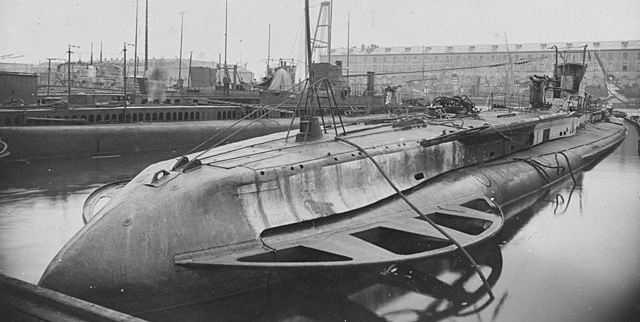
Rear of the u-57 at Cherbourg
| Specifications | |
| Displacement & Dimensions: 810/927 tonnes surface/dive – 68,4 x 6,3 x 4 m. | |
| Propulsion: 2 shafts, 2 MAN diesels, 2 electric engines, 2200/1200 cv – 16,5/9 knots s/dive. | |
| Armament: 4 x500 mm TTs 2 bow, 2 stern, 6 torpedoes, 1x 88mm gun, 1x 7.7mm MG | |
| Crew: 35 | |
 U63 (1916)
U63 (1916)
These three great oceanic submersibles were the work of Germaniawerft. They were derived from the U51 but improved, especially with a diving time brought back to only 50 seconds and more powerful diesels.
From the end of 1916, a 105 mm KL/45 was placed to the front. The U64 was sunk by armed trawlers HMS Lychais and Partridge II in June 1918, the U65 was scuttled in October 1918 and the U63 was reformed in 1919 and broken up in 1920.
| Specifications | |
| Displacement & Dimensions: 786/954 tonnes surface/dive – 67 x 6,3 x 3,8 m. | |
| Propulsion: 2 shafts, 2 MAN diesels, 2 electric engines, 1800/1200 hp – 14,7/8,4 knots s/dive. | |
| Armament: 4 x500 mm TTs 2 bow, 2 stern, 6 torpedoes, 1x 88mm gun, 1x 7.7mm MG | |
| Crew: 35 | |
 U87 (1916-17)
U87 (1916-17)
These were 6 oceanic types were built in Danzig, and launched in 1916-17, completed for the last -U92- in November 1917. Improved but very close to the previous classes, including the U81, they were able to dive in 56 seconds.
They had a mixed armament, an 88 mm KL/30 and a 105 mm KL/45, on the U91 and 92, the latter being replaced by a 105 mm KL/45 AA. Their normal storage was 6 torpedo tubes for 12 torpedoes in reserve.
All but two were lost in operations: The U87 was sunk by two escorts in December 1917, the U88 hit a mine in June 1916, shortly after entering service, the U89 was rammed and sunk by the Roxburgh in February 1918, and the U92 hit a mine in September 1918.
| Specifications | |
| Displacement & Dimensions: 757/998 tonnes surface/dive – 65,8 x 6,2 x 3,9 m. | |
| Propulsion: 2 shafts, 2 MAN diesels MAN 6c 4t, 2 electric engines, 2400/1200 cv – 15,6/8,6 knots s/dive. | |
| Armament: 6 x500 mm TTs 4 bow, 2 stern, 12 torpedoes, 1x 105mm, 1x 88mm gun, 1x 7.7mm MG | |
| Crew: 35 | |

U-86 at sea
 U93 (1916-17)
U93 (1916-17)
This was probably the last great class of oceanic submarines, before the experiments of “submersible cruisers”. First to reach 1000 tons when diving, they had a radius of action of 8300 nautical miles (15 300 km).
Their only apparent limitation was their lack of space for other torpedoes, although the torpedoes may arrive in many neutral ports or by anonymous supply ships.
A total of 24 units were completed out of 41 ordered in 1916, in two groups, the first at Germaniawerft, and the second (U160-172 and 201-212) at Bremer Vulkan.
Most of the second groups were never operational in time or even completed by 30 to 75% when the armistice came, the last two never even started.
Based on the U86 but enlarged, they had Germaniawerft diesels for the first group, MAN and electric engines developing no less than 1230 hp for those of Vegesack.
They could dive in 66 seconds, and were variably armed, most of them having two 105-mm pieces, others only one, others a 88-piece and a 105-or-105 standard gun, which was the configuration of most surviving units at the end of 1918. 7 units were lost in combat and the U111 was offered to the US in war reparation.
The latter studied her extensively, then used her as a target ship, sank in 1919. The others were broken up in 1919-22 in accordance with the Versailles treaty.

En route to surrender, 1918
| Specifications | |
| Displacement & Dimensions: 838/1000 tonnes surface/dive – 71,6 x 6,3 x 3,9 m. | |
| Propulsion: 2 shafts, 2 MAN diesels Germania 6c 2t, 2 electric engines, 2400/1200 cv – 16,8/8,6 knots s/dive. | |
| Armament: 6 x500 mm TTs 4 bow, 2 stern, 12 torpedoes, 1x 105mm, 1x 88mm gun, 1x 7.7mm MG | |
| Crew: 35 | |
 U139 (1917-18)
U139 (1917-18)
These units were called “UK” for “Unterseeboote Kreuzer”. These three great oceanic types were built by Germaniawerft at Kiel. They were launched in December 1917-January 1918 and operational by May-June 1918. This was the second class of this type after the U151, but they were improved in all respects.
Larger, capable of reaching 15.2 knots instead of 14 knots in surface, but reduced to 17,750 nautical miles against 25,000. They were also less well armed, but partially armoured with 30 to 25 mm thick (kiosk, ammunition well) plates. They also embarked a catch crew, a 20-man naval infantry company.
They survived the war and were given in war reparation, the U139 (KL Schwieger) to France (Halbronn, which served until 1935), the U140 to the USA (studied and then used as a target in 1921) and the U141 (KL Weddingen) to UK (studied, then scrapped in 1923). They greatly influenced allies concepts of oceanic submersible cruisers.
| Specifications | |
| Displacement & Dimensions: 1930/2485 tonnes surface/dive – 92 x 9,1 x 5,3 m. | |
| Propulsion: 2 shafts, 2 MAN diesels MAN 6c 4t, 2 electric engines, 3300/1690 hp – 15,3/7,6 knots s/dive. | |
| Armament: 6 x500 mm TTs 4 bow, 2 stern, 19 torpedoes, 2x 150 mm KL/45 , 2x 88 mm KL/30 | |
| Crew: 35 | |
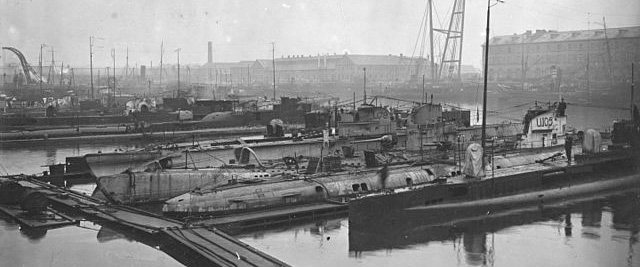
U-105 at Cherbourg
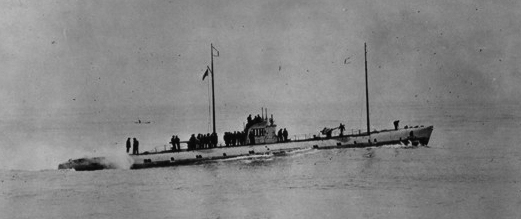
U-111 at sea in 1919, on its way to be a war reparation

U-135 at sea
 U142 (1918)
U142 (1918)
These submersible cruisers were by far the last and most ambitious of this type built in Germany. Inspired by the U139s but even larger (nearly 2,800 tons underwater), they had an improved torpedo carrying capacity (24 against 19 torpedoes), and a range of 20,000 nautical miles (37,000 km).
The series was to comprise 37 units and more in total, construction spread over four yards, including Germaniawerft (3 units), Vulcan, Bremer (2 launched) and Blohm & Voss.
Only one unit was accepted into service, the U142, in November 10, 1918. She did not have the opportunity to patrol and was immediately taken over for demilitarization.
These units used 4-stroke MAN 10-cylinder diesels manufactured under license. A third 150mm was planned for the units of the end of 1918. None being completed outside the U142, they were all broken up in slips between 1919 and 1920
| Specifications | |
| Displacement & Dimensions: 2175/2791 tonnes surface/dive – 97,5 x 9,1 x 5,4 m. | |
| Propulsion: 2 shafts, 2 MAN diesels MAN 10c 4t, 2 electric engines, 6900/2600 hp – 17,5/8,5 knots s/dive. | |
| Armament: 6 x500 mm TTs 4 bow, 2 stern, 24 torpedoes, 2x 150 mm KL/45 , 2x 88 mm KL/3 | |
| Crew: 86 | |
 UA (1914)
UA (1914)
The UA was a single coastal building commissioned by Norway under the name A5. Completed in Kiel in August, she was requisitioned by the Kaiser and incorporated under the name of UA (Unterseeboote A?). She had some excellent performances, could dive in 75 seconds to 50 meters.
Being unique and not integrating a category of the Hochseeflotte, he made some sorties and was in 1916 used as a training ship, until the end of the war. She was broken up in 1920.
| Specifications | |
| Displacement & Dimensions: 270/342 tonnes surface/dive – 47,6 x 4,8 x 2,9 m | |
| Propulsion: 2 shafts, 2 diesels Germania 6c 4t, 2 electric engines, 700/380 cv – 14,2/7,3 knots s/dive. | |
| Armament: 3 x450 mm TTs 2 bow, 1 stern, 4 torpedoes | |
| Crew: 21 | |
 UB-I (1915)
UB-I (1915)
From the beginning of the war, the Admiralty saw the advantage of deploying mass-produced, low-cost units from advanced bases (such as the ports of Holland and Belgium).
It was also possible to deploy such a curtain of units as a trap, for example by dragging the bulk of the Royal Navy by some battlecruisers into the Skaggerak Strait, in order to compensate for the numerical inferiority of the Hochseeflotte. These cheap UBs were produced in two groups at Germaniawerft (Kiel) and Weser at Bremen.
The first were launched in January 1915 and the last, UB17, in April. These very simplified and slow units could dive in 33 seconds to 50 meters.
They carried only 2 torpedoes, housed in their respective tubes, and 3 to 3.5 tons of fuel oil, for a radius of action of 2780 km, thanks to Daimler or Körting diesel engines.
They were assembled in sections, which allowed them to be transported by rail (to Pola or Antwerp). Two units, UB1 and 15 were integrated in the Austro-Hungarian Navy. There were a total of 7 losses in combat and one scuttled on 17 units.
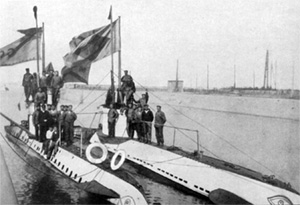
UB-2 and UB-16
| Specifications | |
| Displacement & Dimensions: 127/142 tonnes surface/dive – 28,1 x 3,2 x 3 m. | |
| Propulsion: 2 shafts, 2 diesels 4c 4t, 2 electric engines, 60/120 cv – 6,5/5,5 knots s/dive. | |
| Armament: 1 x450 mm TTs 4 bow | |
| Crew: 14 | |
 UB-II (1915-16)
UB-II (1915-16)
This second class of coastal units was defined from the UB-Is, with a markedly improved radius of action (from 15,000 to 11,900 km) and a higher speed (9 knots instead of 5). This challenge was met with two diesels instead of one.
The hull was similar, but there were two propellers. Diving safety threshold was always 50 meters, but the dive time ranged from 30 to 45 seconds.
Too large to be transported by rail, two units were however bought by the Austro-Hungarians and conveyed to Pola. The others operated from the Belgian and German coasts.
30 were built, launched from August 1915 to June 1916, by Blohm & Voss shipyards in Hamburg and Weser in Bremen.
Their armament varied, some having a 88 mm gun instead of their usual 50 mm. No less than 19 were lost in action, and one scuttled in 1918.
| Specifications | |
| Displacement & Dimensions: 263/292 tonnes surface/dive – 36,1 x 4,4 x 3,7 m. | |
| Propulsion: 2 shafts, 2 diesels Körting/Daimler/Benz, 2 electric engines, 270/285/280 hUB-45p – 9/5,8 knots s/dive. | |
| Armament: 2 x500 mm TTs 2 bow 6 torpedoes, 2x 50 mm KL/40 | |
| Crew: 22 | |

UB-45
 UB-III (1917-18)
UB-III (1917-18)
This last class of coastal units was also by far the most prolific of the war and the most successful. Some would say that they largely inspired post-war clandestine designs and especially the mythical type VII of 1936 at the end of the line.
130 units were planned, finally 92 were completed before the end of hostilities (UB-48 to UB-219). Their range started 13,300 to 16,700 km, they were almost more oceanic than true coastal.
They were built in four large groups at Blohm & Voss, Weser, Vulcan and Germaniawerft, launched from January 1917 to November 1918 – and broken up without being completed, for the latter. They had a double hull and were known to dive more than 50 meters.
They were also much better armed, carrying no less than 10 torpedoes for 5 tubes, 88 mm guns and often 105 mm guns (systematically from the UB88) and were much faster in surface.
There were 37 losses in combat, 4 scuttled in October 1918 and a dozen units delivered to the Allies as war reparation (UK, France, Italy, Japan). The 3 units delivered to France served until 1935 and greatly influenced the design of its first interwar coastal types.
| Specifications | |
| Displacement & Dimensions: 516/651 tonnes surface/dive – 55,3 x 5,8 x 3,7 m. | |
| Propulsion: 2 shafts, 2 Körting/Daimler/MAN/AEG diesels, 2 electric engines, 1100/780 hp – 13,5/7,5 knots s/dive. | |
| Armament: 5 x500 mm TTs 4 bow, 1 stern, 10 torpedoes, 1x 88 mm KL/30 | |
| Crew: 35 | |
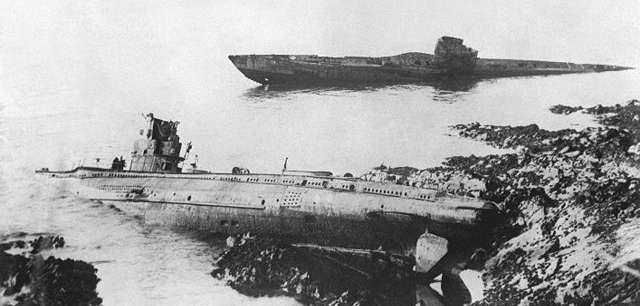
UB-86 grounded at Falmouth with another submarine in 1921
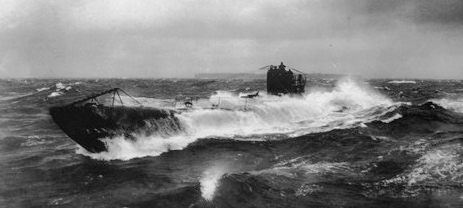
UB-148 at sea
 UC-I (1915)
UC-I (1915)
On the same principle as the UB, the admiralty studied at the same time a coastal minesweeper for mass production. Small UC1s had a lot in common with UB1s. They were built in Vulcan and Weser in two groups, the first launched in April 1915 and the last in July with 15 units.
Again, single hull, simplified ballasts, Daimler engine and single propeller, the standard 100 cm UC120 mines are stored in a series of 6 oblique silos in the center and front, each for two gears. There was no room for a torpedo tube, but the UC-11 served as an experimental ship, being equipped with an external 450 mm tube.
They could dive to 50 meters but their lack of armament made them somewhat vulnerable, as their low speed.
Their range was from 1440 to 1680 km. They were extensively deployed on the Belgian coast and 13 were lost in action. Another was scuttled and one was stranded and captured.
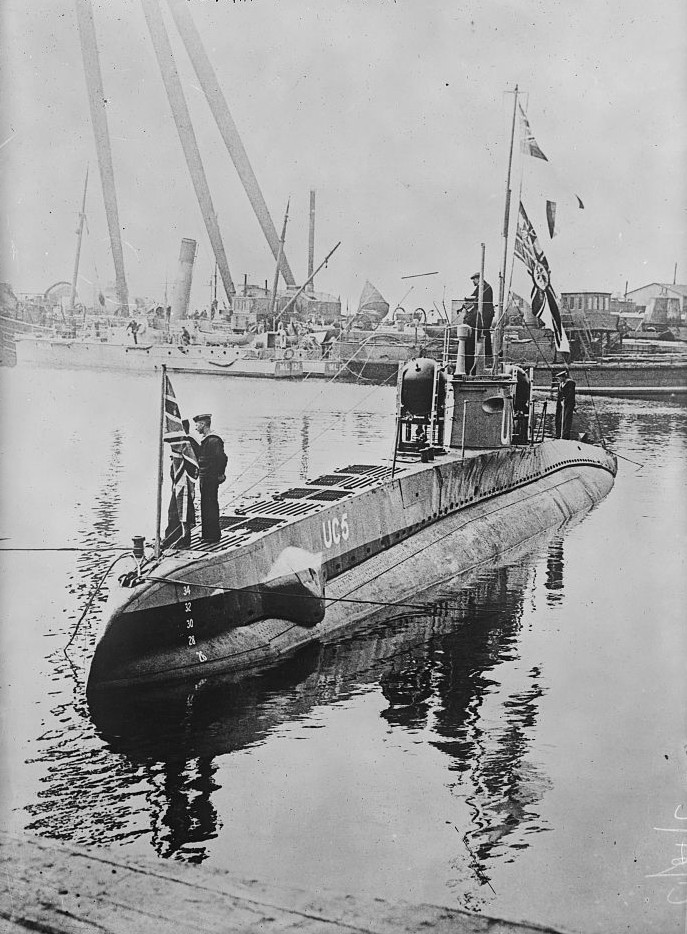
UC-5 in British service
| Specifications | |
| Displacement & Dimensions: 168/183 tonnes surface/dive – 34 x 3,2 x 3 m. | |
| Propulsion: 2 shafts, 2 Daimler diesels, 2 electric engines, 90/175 hp – 6,2/5,2 knots s/dive. | |
| Armament: 12 mines | |
| Crew: 14 | |
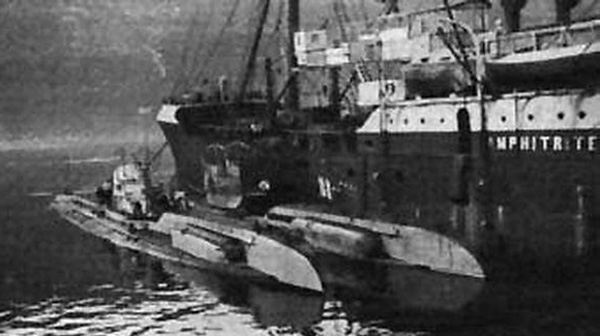
UC-35 at anchor with a depot ship
 UC-II (1916-17)
UC-II (1916-17)
The UC-II series was designed to improve UC-I defects, which are too light and too weak. A series of 64 units was undertaken in four groups by four yards (Blohm & Voss, Weser, Vulcan and germaniawerft).
The series went from UC16 to UC79. The first was launched in February 1916 and the last in March 1917. Their sea keeping was much improved, differed by the adoption of round bow (first) and then clipper bow (the majority).
Their range was 13,500-17,130 km, or 18,500 on the last serie, their top speed was comprised on surface between 11.5 and 12 knots with engine power ranging from 500 to 600 hp.
Finally, their armament was greatly improved, thanks to the addition of two external torpedo tubes at the front and one at the stern with a reserve of 7 torpedoes, and still 6 mine silos arranged at the center and at the front.
Thanks to their draft raised to 3.7 meters, each housing 3 standard mines of one meter diameter UC-120. On some units, the 88 mm was replaced by a 105 mm QF gun.
These numerous units served intensely until the end of the war. Some even hit their own mines, but many were sunk by escort ships (guns, grenades and often spurs, and sometimes by planes). There were a total of 37 combat losses and 5 scuttled. Others were lost when they were transferred in 1919.
| Specifications | |
| Displacement & Dimensions: 417/480 tonnes surface/dive – 49,4 x 5,2 x 3,7 m. | |
| Propulsion: 2 shafts, 2 MAN/Körting/Daimler diesels, 2 electric engines, 500/460 hp – 11,5/7 knots s/dive. | |
| Armament: 18 mines 100 cm, 3 TT 500 mm (2 bow, 1 stern, 7 Torpedoes), 1x 88 mm KL/45. | |
| Crew: 26 | |
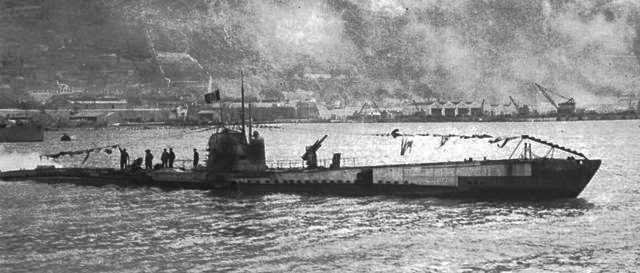
UC-93 off the Italian coast
 UC-III (1918)
UC-III (1918)
As the latest class of German coastal minelayers, the UC-IIIs were developed in parallel with the UB-IIIs and were by far the best class of such units in the world. No less than 115 units were planned, but ultimately only 25 managed to become operational before the end of the war. The first were launched at Blohm and Voss shipyards in Hamburg in January 1918 and the last in August.
Others were started in Weser and Danzig yards but never launched, canceled even before starting construction. They were much larger than the UC-II, their range close to 18,300 km, and their speed when dive somewhat regressed, like their carrying capacity of mines (14 UC 200 in 6 tubes, the rear four carrying 2 mines, and still at the front and center).
Their weaponry was complemented by a 105 mm KL/45 gun instead of a 88 KL/30, taken from some units, and their outer torpedo tubes were relegated after the kiosk but still fired forward.
Their commissioning came very late, so only a few units managed to cross the mine dams deployed by the allies in front of the Straits of Denmark. There was no loss in combat, most units being captured and broken up after the armistice, and some awarded for war damages.
| Specifications | |
| Displacement & Dimensions: 491/571 tonnes surface/dive – 56,5 x 5,5 x 3,8 m. | |
| Propulsion: 2 shafts, 2 MAN diesels, 2 electric engines, 600/770 hp – 11,5/6,6 knots s/dive. | |
| Armament: 14 mines 100 cm, 3x 500 mm TTs (2 bow 1 stern, 7 torpedoes), 1x 105 mm KL/45 | |
| Crew: 32 | |
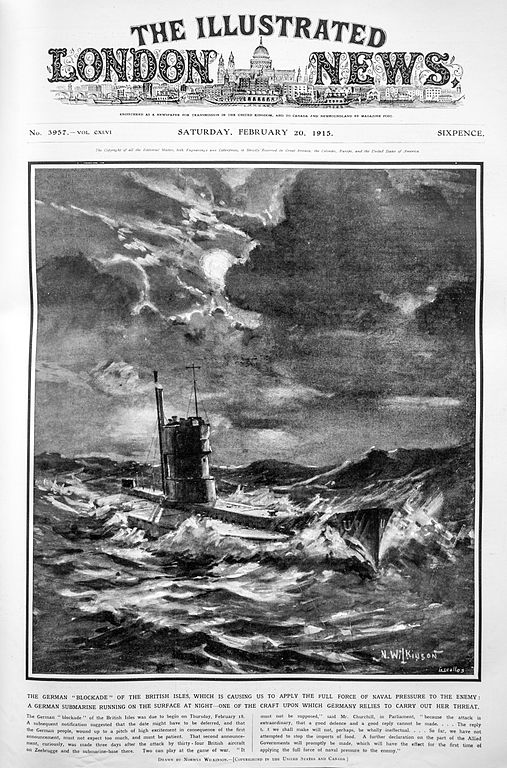
 UE-I (U71-80) (1915-16)
UE-I (U71-80) (1915-16)
These 10 units formed the first class of German submarine minelayers (UE-1). They were built in Danzig (the first pair), the others at the Vulkan shipyards in Hamburg.
4 units had Benz 4-stroke diesels, the others 2-stroke Körting diesels (which had also bought the juicy MAN license). These buildings were short, potty and wide in order to accommodate their two long horizontal mine wells. Each could carry 17 standard mines with individual cables.
The outer and surface torpedo tubes, especially defensive, were placed on the port and starboard aft. The range of the first, U71 and 72, was only 5480 nautical miles at 7 knots.
Apart from the U72 which possessed both a 105 mm and a 88 mm, the units of this class all traded their 88 mm against a 105 mm KL/45 fall 1916, in light of the ongoing operations.
There were 5 losses in action, and two scuttled at the end of the war: The pair U72-73 which operated from Pola on the Adriatic. The U71 was granted to France as war reparation and served until 1933 under the name of Victor Réveille.
| Specifications | |
| Displacement & Dimensions: 755/832 tonnes surface/dive – 56,8 x 5,9 x 4,9 m. | |
| Propulsion: 2 shafts, 2 MAN diesels, 2 electric engines, 900/800 hp – 10,6/7,9 knots s/dive. | |
| Armament: 34 mines, 2x 500 mm TTs (1 bow, 1 stern, 4 torpedoes ), 1 canon de 88 mm, 1 ML 7,7 mm | |
| Crew: 32 | |
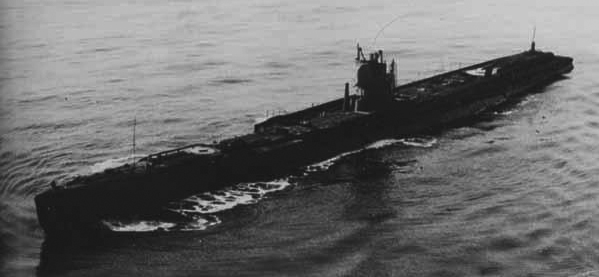
U-117
 UE-II (U117) (1917-18)
UE-II (U117) (1917-18)
Succeeding the UE-I (U71), this second class of oceanic minelayers appeared in 1917, with the stated goal of mining major North American east coast harbors.
They were quite different from the UE-1, much larger at 1512 tons diving vs. 832 and their armament and autonomy (a 152 mm gun, 9400 nautical miles), were similar to the “submersible cruisers” developed at that time.
They were also much better armed, with 4 torpedo tubes in the bow and 12 projectiles in reserve, and they could carry 42 mines in their two rear horizontal wells of 21, and 30 on two rails installed on the rear deck.
They could dive to 75 meters and some were armed differently, like the U117 which had a 88 mm gun at the rear and the U123 which had two 105 mm AA guns.
Of the 8 units launched in December 1917-June 1918 and operational before the armistice, only the former had the time to create havoc on Allied merchant traffic, such as the U117 which sank 24 ships from April 1918 and very seriously damaged the battleship USS Minnesota.
She operated like her twins on the US coast. They survived and were then given as war reparation to France (3), UK (4), the USA (2), and Japan (1), having quite influence on posterior designs.
| Specifications | |
| Displacement & Dimensions: 1164/1512 tonnes surface/dive – 82 x 7,4 x 4,2 m. | |
| Propulsion: 2 shafts, 2 MAN 6c 4t diesels, 2 electric engines, 2400/1200 hp – 14,7/7 knots s/dive. | |
| Armament: 72 mines 100 cm, 4x 500 mm TTs (4 av, 12 torpedoes), 1x 150 mm KL/45, 1 ML 7,7 mm | |
| Crew: 4 | |
Links & Sources, read more
on virtualdockyard.co.uk
on uboat.net/wwi/
theworldwar.org/ unrestricted u-boat warfare
en.wikipedia.org U-boat
en.wikipedia.org/ SM U-1 Germany
submarine-history.com NOVA
en.wikipedia.org List of most successful U-boat commanders
Submarines: An Illustrated History of Their Impact By Paul E. Fontenoy
en.wikipedia.org SM_U-1 Germany
iwm.org.uk/ u-boat-campaign
history.com/ germans-unleash u-boats
on bbc.co.uk/ – Was the WW1 U-boat a death trap
Specs Conway’s all the world fighting ships 1906-1921.
Videos

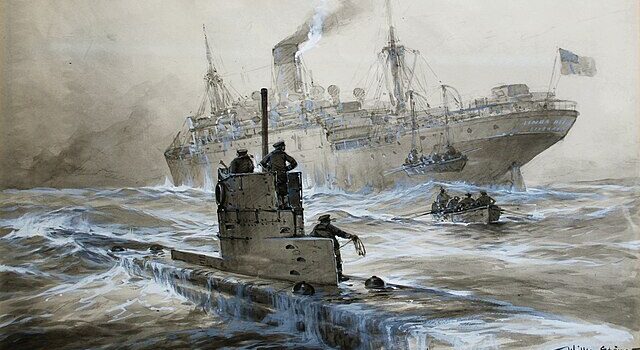


























 Latest Facebook Entry -
Latest Facebook Entry -  X(Tweeter) Naval Encyclopedia's deck archive
X(Tweeter) Naval Encyclopedia's deck archive Instagram (@navalencyc)
Instagram (@navalencyc)





 French Navy
French Navy Royal Navy
Royal Navy Russian Navy
Russian Navy Armada Espanola
Armada Espanola Austrian Navy
Austrian Navy K.u.K. Kriegsmarine
K.u.K. Kriegsmarine Dansk Marine
Dansk Marine Nautiko Hellenon
Nautiko Hellenon Koninklije Marine 1870
Koninklije Marine 1870 Marinha do Brasil
Marinha do Brasil Osmanlı Donanması
Osmanlı Donanması Marina Do Peru
Marina Do Peru Marinha do Portugal
Marinha do Portugal Regia Marina 1870
Regia Marina 1870 Nihhon Kaigun 1870
Nihhon Kaigun 1870 Preußische Marine 1870
Preußische Marine 1870 Russkiy Flot 1870
Russkiy Flot 1870 Svenska marinen
Svenska marinen Søværnet
Søværnet Union Navy
Union Navy Confederate Navy
Confederate Navy Armada de Argentina
Armada de Argentina Imperial Chinese Navy
Imperial Chinese Navy Marinha do Portugal
Marinha do Portugal Mexico
Mexico Kaiserliche Marine
Kaiserliche Marine 1898 US Navy
1898 US Navy Sovietskiy Flot
Sovietskiy Flot Royal Canadian Navy
Royal Canadian Navy Royal Australian Navy
Royal Australian Navy RNZN Fleet
RNZN Fleet Chinese Navy 1937
Chinese Navy 1937 Kriegsmarine
Kriegsmarine Chilean Navy
Chilean Navy Danish Navy
Danish Navy Finnish Navy
Finnish Navy Hellenic Navy
Hellenic Navy Polish Navy
Polish Navy Romanian Navy
Romanian Navy Turkish Navy
Turkish Navy Royal Yugoslav Navy
Royal Yugoslav Navy Royal Thai Navy
Royal Thai Navy Minor Navies
Minor Navies Albania
Albania Austria
Austria Belgium
Belgium Columbia
Columbia Costa Rica
Costa Rica Cuba
Cuba Czechoslovakia
Czechoslovakia Dominican Republic
Dominican Republic Haiti
Haiti Hungary
Hungary Honduras
Honduras Estonia
Estonia Iceland
Iceland Eire
Eire Equador
Equador Iran
Iran Iraq
Iraq Latvia
Latvia Liberia
Liberia Lithuania
Lithuania Mandchukuo
Mandchukuo Morocco
Morocco Nicaragua
Nicaragua Persia
Persia San Salvador
San Salvador Sarawak
Sarawak Uruguay
Uruguay Venezuela
Venezuela Zanzibar
Zanzibar Warsaw Pact Navies
Warsaw Pact Navies Bulgaria
Bulgaria Hungary
Hungary

 Bundesmarine
Bundesmarine Dutch Navy
Dutch Navy Hellenic Navy
Hellenic Navy Marina Militare
Marina Militare Yugoslav Navy
Yugoslav Navy Chinese Navy
Chinese Navy Indian Navy
Indian Navy Indonesian Navy
Indonesian Navy JMSDF
JMSDF North Korean Navy
North Korean Navy Pakistani Navy
Pakistani Navy Philippines Navy
Philippines Navy ROKN
ROKN Rep. of Singapore Navy
Rep. of Singapore Navy Taiwanese Navy
Taiwanese Navy IDF Navy
IDF Navy Saudi Navy
Saudi Navy Royal New Zealand Navy
Royal New Zealand Navy Egyptian Navy
Egyptian Navy South African Navy
South African Navy






























 Ukrainian Navy
Ukrainian Navy dbodesign
dbodesign